Longjing (龙井) or Dragon Well is probably the best known Chinese tea of all and certainly the best known Chinese green tea. Numerous Chinese leaders from Emperor Qian Long of the Qing Dynasty to Chairman Mao Ze Dong have had well-documented love affairs with this variety of tea, accentuating its fame further.
But what is Longjing and what are the different types of Longjing?
We can broadly divide it based on geographical area of harvest and harvest dates.
Categories of Longjing- by Geographical Area
According to the official document GB-T18650/2008, Longjing can be classified according to where it is grown based on the following categories:
1) Xihu Longjing (西湖龙井)
2) Qiantang Longjing (钱塘龙井)
3) Yuezhou Longjing (越洲龙井)
Xihu Longjing (西湖龙井)

The present convention divides Xihu Longjing into the following regions-狮,龙,梅,云,虎 or Shi (Lion), Long (Dragon), Mei (Plum), Yun (Cloud) and Hu (Tiger) respectively.
‘Lion’ Longjing (狮字号西湖龙井)
The ‘Lion’ moniker refers to the area encompassing Shifeng Mountain, Longjing Village, Qipan Mountain and Shangtianzhu.
This area- especially Shifeng Mountain- is considered the premium production area for Longjing. Its tea plants are grown amidst natural lush vegetation and shrouded in mist, protecting the trees from protracted direct sunlight. Much like what the producers of Gyukuro were trying to mimic with the shading of the plants but in an entirely natural manner.
‘Dragon’ Longjing (龙字号西湖龙井)
This refers to Longjing that are grown around Longjing Mountain including Wengjiashan, Yangmeilin, Manjuelong, and Baihefeng. It is the closest in physical proximity and taste profile to the ‘Lion’ Longjing and next highest in regard.
‘Plum’ Longjing (梅字号西湖龙井)
The ‘Plum’ moniker refers to Longjing that are grown in Meijiawu area which accounts for circa 1/3 of all Xihu Longjing produced. Tea leaves produced here are greener compared to the brownish-yellowish green tones of the ‘Lion’ and ‘Dragon’ Longjing.
 ‘Cloud’ Longjing (云字号西湖龙井)
‘Cloud’ Longjing (云字号西湖龙井)

‘Cloud’ Longjing are produced at Yunxi, Wuyunshan and Lingdanglin. Originally part of the ‘Plum’ region, tea leaves produced here shares much of the same characteristics of Meijawu area.
‘Tiger’ Longjing (虎字号西湖龙井)
‘Tiger’ Longjing are produced at Hupao, Chishanfu and Shantaishan. It shares many of the characteristics of Xihu Longjing except that its buds tend to be sturdier and tippier.
Qiantang Longjing (钱塘龙井)
The teas grown on the shores of Qiantang River and Fuchun River are collectively known as Qiantang Longjing. It includes part of Hangzhou including Xiaoshan area. These teas are characterized by a chestnut fragrance and makes up approximately 30% of all Longjing produced.
Yuezhou Longjing (越洲龙井)
As we venture further away from Hangzhou, we reach Shaoxing and the neighboring counties including Sinchang, Chengzhou, Tiantai, Panan, Dongyang and other parts of Zhejiang.
Yuezhou Longjing is characterized by the chestnut fragrance and appearance of ‘downy’ fur on the dry leaves. These Longjing are the most commonly available type of Longjing and makes up over 60% of all Longjing produced in the market.
Categories of Longjing- by Harvest Time
You might have heard of the phrases ‘Pre Qing-Ming’ (明前) or ‘Pre Harvest Rain’ aka ‘Pre Guyu’ (雨前) Longjing. Before we get there, let’s look at the harvest seasons.

As with almost all green teas, spring harvest is the most valued followed by autumn and finally summer. Spring teas are then further divided into ‘Pre Qing-Ming’, ‘Pre Harvest Rain’ and the rest of spring.
Qing Ming refers to the ‘Tomb Sweeping’ Festival in China which occurs annually around 5th of April. Teas harvested around this period are more young and tender and favored for their aesthetic and taste values.
The Harvest Rain is another important marker on the Chinese harvest calendar and refers to teas harvested from around the 6th to the 20th of April each year although this might vary slightly.
Teas that are harvested after the 20th of April till early May then will be known simply as spring teas.
The importance of these dates is that the earlier the dates, the younger and tenderer the leaves and the bud to leaf ratio is lower. You would expect a top grade Pre Qing Ming Longjing to be predominantly 1 bud to 1 partially grown leaf while the weightage of 1 bud to 1 fully grown leaf or 2 leaves increases the later it is harvested.
Not all Pre Qing-Ming teas are created equal though but that is best left for a separate post.
So Longjing or Dragon Well is never merely ‘Dragon Well’. Its place of harvest makes a difference and so does its time of harvest.

Nevertheless, if you can get a good Xihu Longjing or even a good Qiantang or Dafo Longjing, savor it. It’s quite an experience.
Just don’t be mistaken that all Longjings are created equal, especially if you merely had a mediocre one before.
